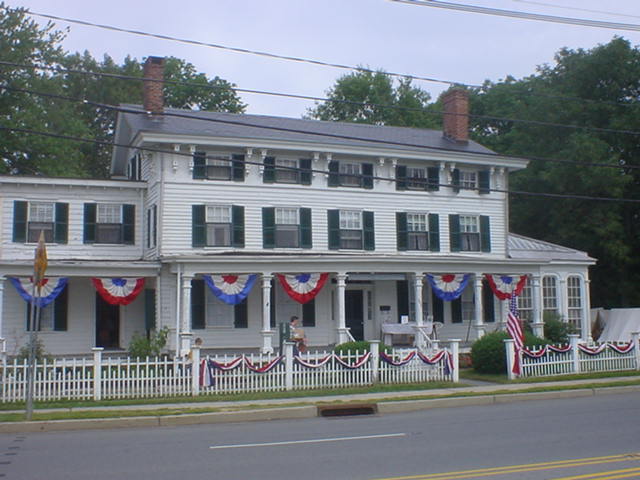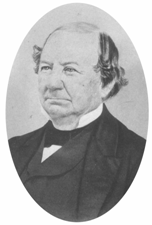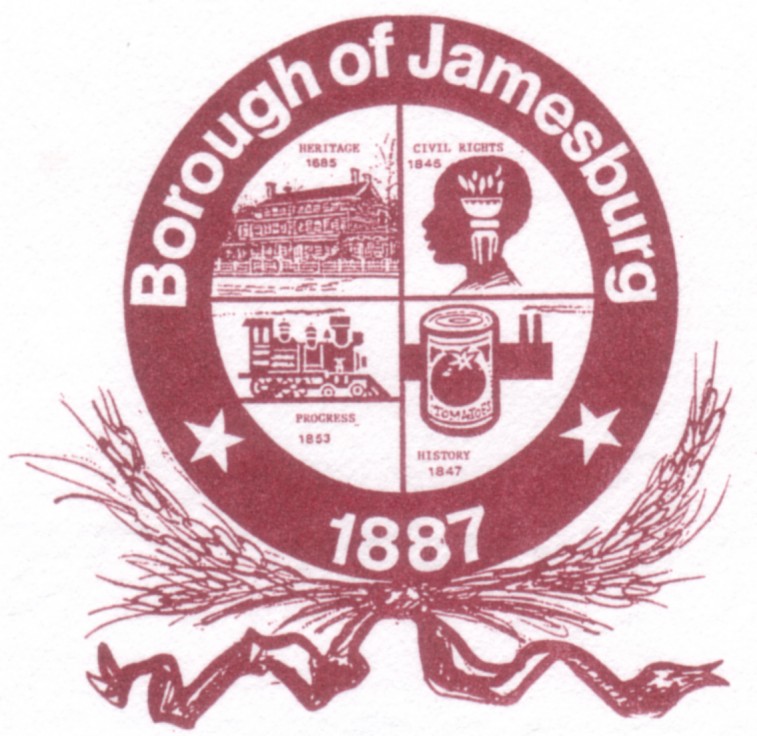A Profile of Jamesburg's History
Lakeview
 You have probably passed Lakeview many times in your travels through Jamesburg, and probably knew it was the Buckelew Mansion, but not much more about the building. Here’s some information on the building’s history.
You have probably passed Lakeview many times in your travels through Jamesburg, and probably knew it was the Buckelew Mansion, but not much more about the building. Here’s some information on the building’s history.
The original part of the house dates back to 1685. It was a one-room house. Over the years additional rooms were added. James Buckelew moved into the house in 1829 following his marriage. As his family size (he and his wife had six children) and prestige in the business community grew, Mr. Buckelew expanded the house to include the two-story front, which included, among other things, a wide center hallway, spacious double parlors and a wide, pillared verandah overlooking Lake Manalapan. Various other additions were made over the years, including the third story in the 1870s, so that today the house is a maze of twenty-three rooms, many closets, pantries, chimney nooks, and cubbyholes of various sizes and degrees of finish. Lakeview was listed in the National Register of Historic Places in 1979 and the State Register in 1981.
James Buckelew died in 1869. Mrs. Buckelew continued to live in Lakeview until her death in 1890. At that time the house was purchased by the Paxton family. This family ran a boarding house here until the house was sold to the Borough of Jamesburg in 1979. In 1979, the Borough entrusted Lakeview to the care of the Jamesburg Historical Association.
Today, the Historic Association maintains Lakeview as Jamesburg’s museum. Many artifacts from Jamesburg’s proud history are housed here. You will see these and many other treasures as you walk through the halls, rooms, buildings and grounds of Lakeview.
James Buckelew
James Buckelew, Jamesburg’s founder and namesake, was born on August 12, 1801, one of eleven children of John and Isabelle Dove Buckelew. On December 12, 1829, James married Margaret Chambers. Together they had six children.
 Until he was 31 years old, James was a successful farmer and businessman, running a small milling operation on his farm, about four miles from Lakeview, in Monroe Township. He then purchased the mill that was located at Lake Manalapan and set up business there. In addition, seeing the possibilities that the “Iron Horse” could provide businesses, he became involved with the Camden Amboy Railroad and later with the Freehold and Jamesburg Agricultural Railroad. His other transportation-related business ventures included a stagecoach line between Jamesburg and Freehold and providing the finest mule towing teams on the Delaware and Raritan Canal. He was one of the largest mule dealers. and the provider of the best mules in the United States.
Until he was 31 years old, James was a successful farmer and businessman, running a small milling operation on his farm, about four miles from Lakeview, in Monroe Township. He then purchased the mill that was located at Lake Manalapan and set up business there. In addition, seeing the possibilities that the “Iron Horse” could provide businesses, he became involved with the Camden Amboy Railroad and later with the Freehold and Jamesburg Agricultural Railroad. His other transportation-related business ventures included a stagecoach line between Jamesburg and Freehold and providing the finest mule towing teams on the Delaware and Raritan Canal. He was one of the largest mule dealers. and the provider of the best mules in the United States.
Mr. Buckelew was also well-known in agricultural circles. He introduced improved farming methods on his 4,000 acres under cultivation and was particularly noted for using marl (sand or clay that contains a substantial amount of calcium carbonate) as fertilizer on his farms. He was also involved in growing cranberries, owning two bogs, the largest single tract in the State of New Jersey for cranberry production.
Of Mr. Buckelew’s many other business ventures, four are also worth mentioning: his draining tile factory produced 3,000 tiles daily, his brick kilns produced 800.000 bricks annually, his gristmill became one of the largest in the country, and his establishment, in 1864, of the First National Bank of Jamesburg, one of the earliest to be chartered by the United States Government. All this in Jamesburg, New Jersey.
James Buckelew died on May 30, 1869. He was interred in the family plot in Fernwood Cemetery.
About Jamesburg
 Prior to the coming of settlers, the town we call Jamesburg was occupied by the Leni Lenape Indians. They fished in Lake Manalapan (which means “Land of Good Bread”). Settlers arrived in the late 1600s. A sawmill was established by 1685. At the time Jamesburg was a part of South Amboy Township, which was created that same year from the South Ward of Perth Amboy.
Prior to the coming of settlers, the town we call Jamesburg was occupied by the Leni Lenape Indians. They fished in Lake Manalapan (which means “Land of Good Bread”). Settlers arrived in the late 1600s. A sawmill was established by 1685. At the time Jamesburg was a part of South Amboy Township, which was created that same year from the South Ward of Perth Amboy.
Records indicate that there was a gristmill in operation at Jamesburg well before the American Revolution, probably as early as 1734. In 1746, the Reverend David Brainerd established “Bethel,” an Indian mission. This mission consisted of 160 Indians living in log houses with a log school and church, cultivating 80 acres of corn, grain and fruit. The mission closed in 1760. The area was also dotted with prosperous farms.
During the Revolutionary War, Washington’s Army marched through the area on their way to the Battle of Monmouth, June 28, 1778. It’s very possible that some of Washington’s soldiers stopped at the gristmill for supplies.
Between 1787-1832, Jamesburg was known as “Enlsey’s Mills,” “Rossell’s Mills,” “Mount’s Mills,” and “Gordon’s Mills.” James Buckelew purchased the mill in 1832, at which time it became “Buckelew’s Mills.” In 1838, Buckelew’s Mills became part of the newly-created Township of Monroe.
A school is responsible for the town assuming the name “Jamesburg.” In 1847, James Buckelew built a brick school on the corner of Church Street and Gatzmer Avenue, today the location of the Presbyterian Church of Jamesburg’s parking lot. He built the schoolhouse because the Monroe school system refused admittance to an African-American boy. He declared his school open to all children. At the dedication ceremony, the people proclaimed it as the “James B.” or “Jamesburg” school, after this the town came to be known as “Jamesburg.”
By 1887, Jamesburg’s interests were so different from that of the rest of Monroe Township that there was a successful movement to establish a commission form of government. Jamesburg became a completely independent Borough on April 27, 1896.
Over the years Jamesburg has played an important part in National and World history. The first canned tomatoes were canned in Jamesburg in 1847, and the home of the Downs and Finch Shirt Factory, the largest of its kind in the world, from 1877 until it burned in 1900. Jamesburg was also an important railroad town, with two main lines and a roundhouse.

Jamesburg’s proud history is reflected in our borough seal. The Jamesburg Borough seal depicts four historical aspects of our town (clockwise from top left): Lakeview, the home of our town’s founder and namesake. The original part of the house was constructed in 1685. Civil Rights, Mr. Buckelew opened our town’s first school in 1846 when school officials in Monroe Township (Jamesburg was still a part of the Township) refused to admit one of his African-American worker boys. History, among Jamesburg’s historical distinctions, the first tomatoes to be canned in tin cans occurred in 1847; and Progress, Mr. Buckelew, recognizing the great possibilities of the “iron horse,” founded the Freehold and Jamesburg Agricultural Railroad in 1853.

 You have probably passed Lakeview many times in your travels through Jamesburg, and probably knew it was the Buckelew Mansion, but not much more about the building. Here’s some information on the building’s history.
You have probably passed Lakeview many times in your travels through Jamesburg, and probably knew it was the Buckelew Mansion, but not much more about the building. Here’s some information on the building’s history.
 Until he was 31 years old, James was a successful farmer and businessman, running a small milling operation on his farm, about four miles from Lakeview, in Monroe Township. He then purchased the mill that was located at Lake Manalapan and set up business there. In addition, seeing the possibilities that the “Iron Horse” could provide businesses, he became involved with the Camden Amboy Railroad and later with the Freehold and Jamesburg Agricultural Railroad. His other transportation-related business ventures included a stagecoach line between Jamesburg and Freehold and providing the finest mule towing teams on the Delaware and Raritan Canal. He was one of the largest mule dealers. and the provider of the best mules in the United States.
Until he was 31 years old, James was a successful farmer and businessman, running a small milling operation on his farm, about four miles from Lakeview, in Monroe Township. He then purchased the mill that was located at Lake Manalapan and set up business there. In addition, seeing the possibilities that the “Iron Horse” could provide businesses, he became involved with the Camden Amboy Railroad and later with the Freehold and Jamesburg Agricultural Railroad. His other transportation-related business ventures included a stagecoach line between Jamesburg and Freehold and providing the finest mule towing teams on the Delaware and Raritan Canal. He was one of the largest mule dealers. and the provider of the best mules in the United States.
 Prior to the coming of settlers, the town we call Jamesburg was occupied by the Leni Lenape Indians. They fished in Lake Manalapan (which means “Land of Good Bread”). Settlers arrived in the late 1600s. A sawmill was established by 1685. At the time Jamesburg was a part of South Amboy Township, which was created that same year from the South Ward of Perth Amboy.
Prior to the coming of settlers, the town we call Jamesburg was occupied by the Leni Lenape Indians. They fished in Lake Manalapan (which means “Land of Good Bread”). Settlers arrived in the late 1600s. A sawmill was established by 1685. At the time Jamesburg was a part of South Amboy Township, which was created that same year from the South Ward of Perth Amboy.